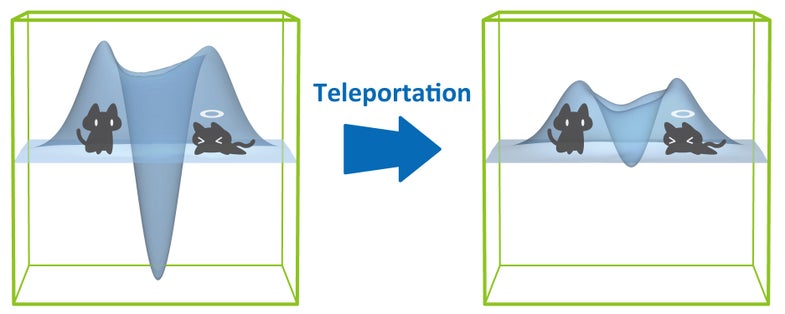Scientists Achieve On-Demand Quantum Teleportation For The First Time
Quantum teleportation, more reliable than ever before, at greater distances than ever before.

Quantum teleportation has taken another step forward, thanks to two complimentary experiments, one from ETH Zurich and one from the University of Tokyo. The researchers have demonstrated the most reliable yet version of quantum teleportation–what Nature is calling “quantum teleportation on demand.”
A quick explanation of quantum teleportation, from the Nature abstract:

Quantum Teleportation: Fig. 1
Generically, teleportation protocols proceed by three steps (Fig. 1): a pair of quantum systems in an entangled state is produced and distributed, one to a sender (Alice) and the other to a receiver (Bob); Alice makes a joint measurement of her member of the entangled pair and the unknown state she wishes to teleport, and sends the measurement result to Bob; Bob uses the measurement result he receives from Alice to manipulate his quantum system in a predetermined way. After this manipulation, Bob’s quantum system ends up being in the unknown state, that teleported from Alice to Bob, with the only direct communication being a classical message — Alice’s measurement result.
Quantum teleportation has some pretty significant implications for communications; it works in a way not that dissimilar from the PGP-secured email we outlined here, except there’s literally no physical link between the sender and receiver. (Read more about the implications for communications in Rebecca Boyle’s excellent explainer.)
In the new experiments, conducted at the 100-micrometer scale and at temperatures of around 20 millikelvins, “Alice” and “Bob” from the example above are separated by about 5 mm. The University of Tokyo experiment managed to induce entanglement deterministically, which had only been done before at distances about 1,000 times smaller. And those previous experiments had only managed to do so reliably about 1 percent of the time, compared to this experiment, which teleported a qubit about 40 percent of the time (and reproduced it on the other end with about an 88 percent accuracy). So this is a huge leap forward!